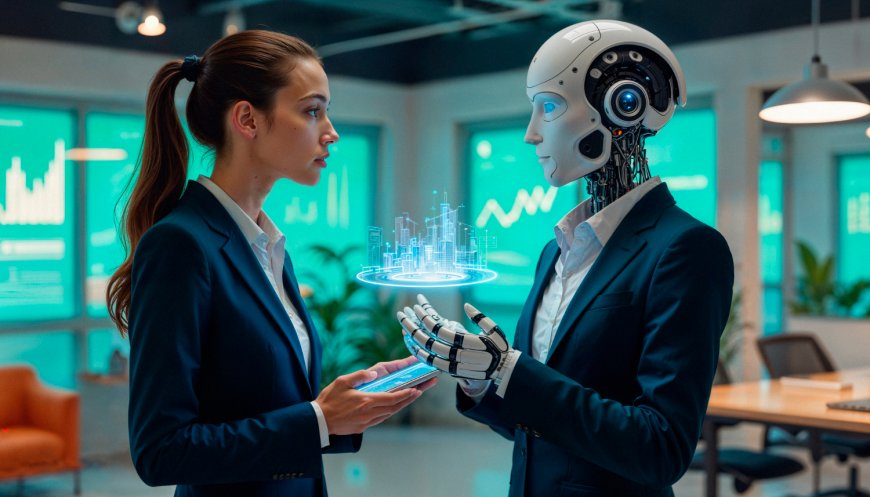Top 7 Trends Shaping AI Agent Development Today
Discover the top 7 trends driving the evolution of AI agents in 2025—from autonomous decision-making to real-time collaboration and ethical design. Stay ahead in AI development.

Artificial Intelligence (AI) agents are no longer just passive tools responding to human commands they are evolving into autonomous, proactive collaborators capable of making decisions, learning over time, and interacting with complex systems. From smart assistants and customer service bots to complex decision-making agents in finance, gaming, and robotics, AI agents are redefining digital interactions.
As this transformation unfolds, several key trends are emerging in the AI agent development landscape. These trends not only reflect technological progress but also illuminate where the future is headed. Here are the top 7 trends currently shaping the development of AI agents.
1.Multi-Agent Collaboration and Swarm Intelligence
One of the most exciting areas of AI agent development is multi-agent systems (MAS), where multiple agents operate collaboratively (or competitively) within a shared environment. This mirrors real-world ecosystems think of a group of delivery drones coordinating tasks or trading bots interacting in a decentralized finance (DeFi) market.
Swarm intelligenceinspired by nature (e.g., ants, birds, fish)is becoming a model for creating robust, decentralized systems. These agents communicate locally but exhibit globally intelligent behavior.
Why it matters:
-
Enables scalability without central control.
-
Encourages emergent behavior and resilience.
-
Suitable for robotics, logistics, simulations, and distributed networks like blockchain.
2.Autonomous Goal-Seeking Agents
AI agents are becoming increasingly goal-driven, capable of planning and executing multi-step tasks with minimal human oversight. This goes beyond simple input-output interactionsagents like OpenAI's AutoGPT or Metas CICERO demonstrate the ability to set objectives, retrieve tools, and evaluate outcomes independently.
Key Features:
-
Use of Reinforcement Learning (RL) and planning algorithms like Monte Carlo Tree Search (MCTS).
-
Ability to break goals into sub-goals (task decomposition).
-
Continuous self-improvement through feedback loops.
Use Cases:
-
Automated research assistants.
-
Coding agents that debug and improve software.
-
Autonomous scientific discovery tools.
3.Tool-Use and Integration with External APIs
Modern AI agents are being designed to use tools calculators, search engines, databases, or even other software applications to extend their capabilities. This is a shift from static models to tool-augmented agents, where the agent understands when and how to call the right tool for a task.
Examples:
-
Agents that can write and execute code using Python or Shell.
-
Research assistants that can browse the web for current data.
-
Chat agents that interact with CRMs or e-commerce platforms.
Impact:
-
Bridges the gap between large language models (LLMs) and the real world.
-
Reduces hallucinations and increases task accuracy.
-
Enables real-time decision making with fresh data.
4.Embodied AI and Robotics Integration
AI agents are also moving from software-only environments into the physical world. Embodied AI refers to agents with a physical formrobots, drones, vehiclesthat interact with the environment using sensors and actuators.
With advances in simulation environments (like OpenAI Gym, MuJoCo, Habitat) and low-cost robotics hardware, developers can train agents in virtual spaces before deploying them physically.
Why it matters:
-
Enhances perception, navigation, and manipulation tasks.
-
Critical for autonomous vehicles, warehouse automation, and home robotics.
-
Pushes boundaries in real-time decision-making and adaptation.
5.Personalized and Emotionally Intelligent Agents
Todays AI agents are becoming more personalized and emotionally aware, especially in human-facing applications like virtual assistants, therapy bots, and education tutors. By understanding user preferences, tone, and context, agents can deliver highly tailored responses.
Thanks to advances in affective computing and user modeling, agents can:
-
Adapt tone and behavior based on user emotions.
-
Remember past interactions to maintain long-term relationships.
-
Adjust difficulty, pacing, or style in learning or entertainment contexts.
Tools Behind This Trend:
-
Sentiment analysis APIs.
-
Memory modules in LLMs.
-
Multi-modal models that analyze text, voice, and facial cues.
6.Open-Ended Learning and Self-Improvement
Unlike traditional agents trained on a fixed dataset or task, the latest generation of AI agents embraces open-ended learninga continual process where agents evolve, learn new tasks, and adapt without explicit retraining.
This involves:
-
Meta-learning (learning how to learn).
-
Online learning through new experiences or user feedback.
-
Dynamic reward shaping and goal adaptation.
Real-World Impact:
-
Agents that get better at their jobs over time.
-
Systems that learn from failure or novel inputs.
-
Greater autonomy in dynamic environments (e.g., games, finance, cybersecurity).
7.Agent Frameworks and Ecosystem Growth
A final but crucial trend is the proliferation of open-source agent frameworks and platforms, making AI agent development more accessible. These frameworks abstract the complexity of orchestration, memory, planning, and tool use, allowing developers to focus on high-level design.
Popular Frameworks:
-
LangChain: Chains together LLMs, tools, and memory components.
-
AutoGen (Microsoft): Enables multi-agent conversations and planning.
-
CrewAI: Agent orchestration with team roles and collaboration.
-
BabyAGI & AutoGPT: Goal-seeking autonomous agents using LLMs + tools.
Why it matters:
-
Democratizes access to agent development.
-
Encourages modular and reusable architecture.
-
Accelerates prototyping for real-world applications.
Honorable Mentions
While the top 7 trends dominate the space, other emerging developments are worth noting:
-
Multi-modal agents: Integrating vision, text, audio, and more.
-
Privacy-aware agents: Using on-device processing or federated learning.
-
Regulatory and ethical constraints: Designing responsible agents with built-in constraints.
Conclusion
We are in the midst of a fundamental shift in how software is designed and interacts with the world. AI agent development is moving from reactive to proactive, from isolated to collaborative, and from general to deeply personalized.
As these trends converge, the next wave of AI agents will not only respond to user prompts but also anticipate needs, coordinate complex tasks, and improve autonomously. Developers, researchers, and businesses that stay ahead of these trends will shape the future of intelligent, agent-based computing.
Whether you're building tools, orchestrating agent teams, or designing for robotics and real-world applications, now is the time to explore and contribute to the AI agent revolution.












































